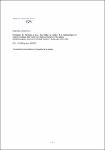Vitamin D status and health correlates among German adults
Hintzpeter, Birte
Mensink, Gert
Thierfelder, Wulf
Müller, MJ
Scheidt-Nave, Christa
Objective: To analyze vitamin D status based on serum 25-hydroxyvitamin D (25OHD) measurements, its determinants and health correlates in a representative sample of German adults. Subjects: A total of 1763 men and 2267 women, 18- to 79-year old, who participated in the representative German National Health Interview and Examination Survey 1998 and the integrated German Nutrition Survey. Results: The median vitamin D intake from both diet and supplements did not meet the recommended level of 5 microg/day, in either men (2.8 microg/day) or women (2.3 microg/day). Altogether 80.9% of men and 88.5% of women had vitamin D intakes below this level. Moderate (12.5-25 nmol/l serum 25OHD levels) and mild (25-50 nmol/l) vitamin D deficiency was prevalent in the adult population in Germany, even in younger age groups. Overall, 57% of men and 58% of women had vitamin D levels below 50 nmol/l. Among 65- to 79-year-old women, the proportion amounted to 75%, even during the sunnier half of the year. In sex-specific multiple linear regression models, independent determinants of serum 25OHD levels consistently included season, vitamin D intake from both diet and supplements, physical activity and living in a partnership. In addition, age and current menopausal hormone use contributed to the model among women, as opposed to time of day of blood sampling and body mass index (marginally) among men. Significantly lower serum 25OHD levels were observed in women with hypertension, cardiovascular diseases and noninsulin-treated diabetes mellitus as well as in men with insulin-treated diabetes mellitus compared with nonaffected participants. Conclusions: Vitamin D deficiency is a public health issue in Germany. We identified a number of determinants with potential for primary prevention of vitamin D deficiency. Risk and benefits of preventive actions need to be examined in further studies.
No license information
Related Items
Show related Items with similar Title, Author, Creator or Subject.
-
2015-07-11ZeitschriftenartikelVitamin D status among adults in Germany – results from the German Health Interview and Examination Survey for Adults (DEGS1) Rabenberg, Martina; Scheidt-Nave, Christa; Busch, Markus A.; Rieckmann, Nina; Hintzpeter, Birte; Mensink, GertBackground: In 1998, more than half of the adult population in Germany had serum 25-hydroxy-vitamin-D [25(OH)D] levels below the common threshold of 50 nmol/l. Since then, there has been a lot of attention for vitamin D ...
-
2017-02-23ZeitschriftenartikelVitamin D and mortality: Individual participant data meta-analysis of standardized 25-hydroxyvitamin D in 26916 individuals from a European consortium Gaksch, Martin; Jorde, Rolf; Grimnes, Guri; Joakimsen, Ragnar; Schirmer, Henrik; Wilsgaard, Tom; Mathiesen, Ellisiv B.; Njølstad, Inger; Løchen, Maja-Lisa; März, Winfried; Kleber, Marcus E.; Tomaschitz, Andreas; Grübler, Martin; Eiriksdottir, Gudny; Gudmundsson, Elias F.; Harris, Tamara B.; Cotch, Mary F.; Aspelund, Thor; Gudnason, Vilmundur; Rutters, Femke; Busch, Markus A.; Mensink, Gert; Scheidt-Nave, Christa; Thamm, Michael; Pilz, StefanBackground: Vitamin D deficiency may be a risk factor for mortality but previous meta-analyses lacked standardization of laboratory methods for 25-hydroxyvitamin D (25[OH]D) concentrations and used aggregate data instead ...
-
1998-10-01ZeitschriftenartikelAnwendung von Vitamin E bei rheumatischen Erkrankungen? Reiter, Susanne

